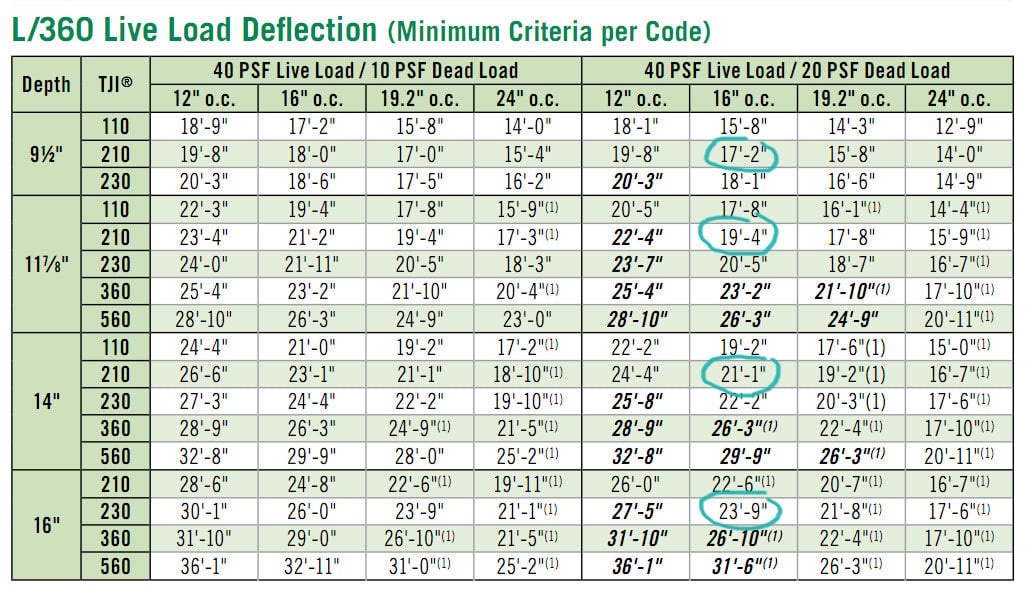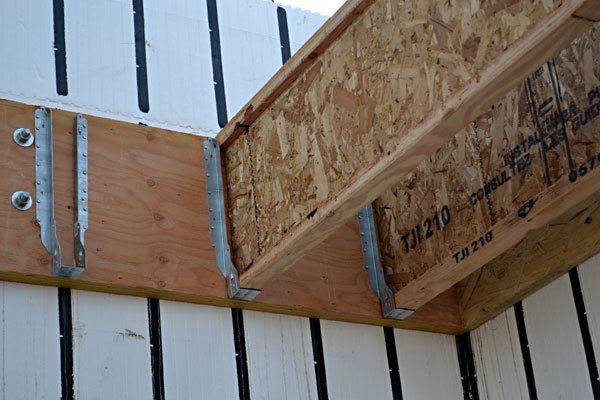Except for a very brief stint on the scaffolding system, we've been working in a giant hole in the ground all summer.




You can click this diagram for a larger view. Only one half of the floor joists are shown in the diagram. Both sides are to be completed the same.<div><br></div><div>We did quite a bit of planning and figuring for this floor. Although, it's really a simple floor, with floor joists being hung on the hangers on the ledger boards, and resting on top of the center load bearing wall. I guess it's the tons of planning that makes things really simple!</div><div><br></div><div>I'll cover in a second post the stair openings - for those of you interested in the easy way I could come up with for framing a split level entry.</div><div><br></div><div>The joist need to span 20 feet 9 inches long and with everything else on 16" centers, we knew the floor joists should be 16" on center.</div>

Using span tables, these from the<a href="http://www.ilevel.com/literature/TJ-4000.pdf" title="" target="_blank"> TGI joist manufacturer's websit</a><a href="http://www.ilevel.com/literature/TJ-4000.pdf" title="" target="_blank">e,</a> we knew we would need at minimum 14" TGIs. TGIs are basically engineered floor joists that tend to be straighter and stronger than tradditional 2x boards. You'll see lots of pictures of them in this post and beyond, I promise.<div><br></div><div>One of the downfalls of living in Alaska is you can't always get what you need, unless you special order it. With winter fast approaching, we do not have seven weeks to wait for 14" TGIs.</div><div><br></div><div>So we went ahead with what was stocked locally, the 16" TGIs. Thus the <a href="http://ana-white.com/2011/10/momplex/how-frame-floor-inside-icf-walls-p…; title="" target="_blank">matching 16" LVLs and Rim Boards in this post.</a></div><div><br></div>

Good thing they deliver! The Joists arrived in 60' lengths!!!
Note to other builders - we really wish we had spanned less than 20 feet, because under 20 feet we could have used 12" TGIs for major savings. And because the cutoff for not having to buy all 60 feet of the joist is 40 feet, we are left with a pile of 18' scraps and quite a bit of money wasted .... so consider building under 40 feet overall as well. Lessons learned ... oh well, Mom get's a wider hallway out of the deal!
PS - The 18' scraps won't go to waste, we just have no use for them on this jobsite.

First we take a measurement of the length needed for the joist, and then mark a joist to this measurement.

Then "stickers" are put under the joist on either side of the cut to elevate the joist at the cut. Then the joists are cut to size.<div><br></div><div><img src="http://ana-white.com/sites/default/files/tgi-floor-joist-tables-8.jpg " alt="" align="none"></div><div><br></div><div>Later we would get smart (Thanks Uncle Bill!) and add a piece of plywood over the OSB part of the joist so cutting with a saw isn't such a bumpy ride. Think of it like trying to ride your bike down one sidewalk curb, across the road, and up another sidewalk curb ... much smoother if everything is the same height!</div>

I really miss this guy, cause now it's my head holding up the other end. That, and he's remarkably optimistic and just in general makes work more fun and funny.
Anyway, the center end of the joists are lifted up on to the center load bearing wall.

And then the other end is lifted up and snapped in to the preinstalled joist hangers.
I tell you, this system is slick. Everything just works together so smoothly!

Of course anytime work is going smoothly, you are either headed for a not so nice surprise, or you've done your homework. <div><br></div><div>In our case, we've put in quite a bit of time planning, and you can see, we even placed the anchor bolts so they would not hit on a joist. We did this by simply marking all joists on the foam blocks before <a href="http://ana-white.com/2011/08/momplex/anchoring-floor" title="" target="">putting the anchor bolts in.</a></div>

Once all the joists are in, it's almost like we are upstairs ... almost.
Boards are layed over the joists, and marked 16" on center. Then the boards are screwed to the tops of the joists to the marks to keep the joists in the right position until plywood is installed on top.

Then scraps are used to create blocking over the center load bearing wall. You see, with a wall on top and bottom, the joists could get "squished" and the blocking will help out tremendously here. If you are installing TGIs, consult your manual or the manufacturer's website on blocking and web stiffener requirements.

So all we need now is plywood on top of these joists and we'll be upstairs!
Can't hardly wait!!!

Comments
Guest (not verified)
Tue, 10/11/2011 - 03:38
I can't hardly wait
emmarosemc
Tue, 10/11/2011 - 06:35
OMG that looks amazing! I get
Guest (not verified)
Tue, 10/11/2011 - 06:54
You're a true inspiration
ferbit
Tue, 10/11/2011 - 10:09
What an exciting post!!!
Jasmine (not verified)
Tue, 10/11/2011 - 11:10
I'm excited too and it's not
Ana White
Tue, 10/11/2011 - 12:01
Thank you everyone, for being
loniwolfe
Tue, 10/11/2011 - 21:32
This looks amazing! I bet
birdsandsoap
Wed, 10/12/2011 - 10:29
It literally felt like